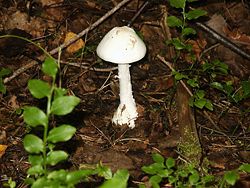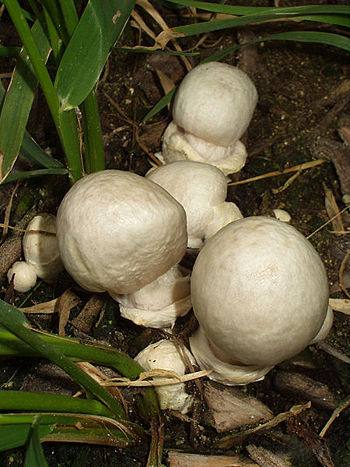Amanita virosa
For the course duration, the article is closed to outside editing. Of course you can always leave comments on the discussion page. The anticipated date of course completion is May 21, 2009. One month after that date at the latest, this notice shall be removed. Besides, many other Citizendium articles welcome your collaboration! |
 | ||||||||||||||||
| Scientific classification | ||||||||||||||||
| ||||||||||||||||
| Binomial name | ||||||||||||||||
Classification and naming
Amanita virosa or the European destroying angel is one of a group of deadly pure white mushroom species known as a group as the destroying angels or the death angels. Amanita virosa is one of the most poisonous of all known toadstools. It belongs to the fungi kingdom; a poisonous basidiomycete fungus, one of many in the genus Amanita.
Amanita virosa was first collected and described by Elias Magnus Fries a Swedish mycologist and botanist.
Description
Amanita virosa is pure white in appearance with gills which are usually not attached to the stalk. The cap of the Destroying Angel is 2¼ to 6 inches wide. In young specimens, a white, membranous partial veil tissue extends from the edge of the cap to the upper stalk, covering the gills and later remaining attached to and draping from the upper stalk. The stalk is white and up to 8 inches long or tall, with a small, rounded bulb at the base; the bulb is enclosed by a sac-like volva. The base of the stalk and the volva are often buried in the soil. All parts of the Destroying Angel are white and turn bright yellow with the use of potassium hydroxide (KOH).
Young specimens of A. virosa are sometimes mistaken for puffballs or other non poisonous mushrooms and are picked and eaten.
Distribution and habitat
A. virosa is found in late summer and autumn under broad leaved trees in mixed woodland, especially in association with beech, on mossy ground. All Amanita species form symbiotic relationships with the roots of certain trees.
Toxicity
Amanita virosa is highly toxic, and has been responsible for severe mushroom poisonings. Consumption is a medical emergency leading to necessary hospitalization. Although it closely resembles edible field mushrooms and puffballs, the Destroying Angel is one of the most poisonous of all known toadstools, containing amatoxins and phallotoxins that cause severe and usually fatal, liver and kidney damage.
The poison in the death angel is a relatively small protein made up of eight amino acids, a cyclopeptide called alpha-amanitin. Alpha-amanitin works by attacking RNA polymerase in the liver. The liver is mainly affected, since it is the first organ which is encountered after absorption in the gastrointestinal tract. The poison ultimately affects the central nervous system and the kidneys.
The first symptoms of poisoning are vomiting, persistent diarrhea, and severe stomach pains; the onset of symptoms normally occurs some eight to ten hours or as long as twenty-four hours after consumption. After this there may be a period of seeming improvement before the second effect of the poisoning occurs; this is deterioration in both liver and kidney functions. These will or may show up as a yellowing or discoloration of the whites of the eyes and skin, and discoloration of the urine.
Death usually takes place within a week to ten days from ingestion, progressing through a comatose stage to renal failure, liver failure, hepatic coma, respiratory failure and death.
Those who recover are at risk of permanent liver damage. Diagnosis is generally very difficult, and is established by observation of the clinical symptoms as well as the presence of amanitin in the urine. Urine screening is generally the most useful within 48 hours of mushroom consumption.
Treatment
See also
http://en.wikipedia.org/wiki/List_of_Amanita_species
Sources
1. http://en.wikipedia.org/wiki/Amanita_virosa
2. http://www.rogersmushrooms.com/gallery/DisplayBlock~bid~5564.asp
3. http://botit.botany.wisc.edu/toms_fungi/sept97.html
4. http://www.mykoweb.com/picpages/vacation2003.html
5. http://www.nybg.org/bsci/res/hall/virosa.html
6. http://www.uoguelph.ca/~gbarron/MISC2003/amanviro.htm
7. http://courses.bio.psu.edu/bio414/Othrorg.html
8. http://tolweb.org/onlinecontributors/app?page=ViewImageData&service=external&sp=35459
